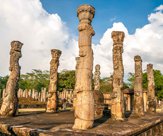The Sinhala & Tamil New Year in Sri Lanka (Aluth Avurudda අලුත් අවුරුද්ද or Puthandu புத்தாண்டு) celebrates the end the harvesting season. The dawn of the New Year is based on the sun’s astrological movement from the Meena Rashiya (House of Pisces) to the Mesha Rashiya (House of Aries), bringing to an end the harvesting season. This festival is celebrated in the month of April and at this time the sun is directly above the island.
April is known as Bak in the Buddhist calendar and the people of Sri Lanka welcome the Sinhala & Tamil New Year with loud bursts of firecrackers. The Erabadu trees (Erythrina variegatea) are in full bloom during this period and everyone hopes for continued peace and prosperity.
Astrology and importance of the ‘Nakath’ Time
The dawn of the Sinhala & Tamil New Year is unique in that it does not take place at a specific time every year (ie. Midnight), but at a time specified according to astrological calculations. Furthermore the duration of time between the end of the old year and beginning of the new one is sometimes as long as 12 hours and 48 minutes. This is when the sun begins to cross the astrological border of Meena Rashiyaand Mesha Rashiya, ending when the crossing is complete.
When the sun crosses the point midway between these two, it signifies the dawn of the New Year. This period of transition is considered a neutral period (Nonagathe) and as tradition dictates material pursuits are avoided and emphasis is on religious activities or traditional games.
Every part of this festival is carried out according to astrologically determined ‘auspicious times’ or Nakath.
Preparing the Avurudu Meals
Preparations for this great festival begins weeks in advance when families clean and paint their homes, buy new clothes and gifts for family members. A very important purchase is the new clay pot in which the milk will be boiled on New Year’s Day. Traditional sweetmeats such as Kavum (small oil cakes), Kokis (a crisp, crunchy sweetmeat), Aluwa (diamond shaped sweets made of rice flour), mung kavum and many others are also prepared in advance and stored in readiness for the great day. A Cuckoo bird known as Koha (කොහා) is in its mating season around this time and the unique mating call of the male is regarded as the harbinger of this festival.
The auspicious times for lighting the hearth and boiling a pot of milk are announced by thousands of firecrackers. Families gather around the fire to watch the milk boil over as it is considered a symbol of good luck. Kiribath (milk-rice) is prepared and the family partakes of a meal which also includes the previously prepared sweetmeats and fruits (bananas). The first business transaction of the New Year too is carried out at a specified time.
Avurudu Rituals, Music and games
Presenting elders with a sheaf of Betel leaves and paying homage is a custom practiced on all important occasions in Sri Lanka, New Year included. Gifts are also exchanged and the rest of the day is spent visiting relatives and engaging in New Year games with members of the community. The Rabana a wide, flat drum is an important feature of the Avurudu celebrations, and it is played by groups of villagers, mainly females accompanied by lyrical versus called raban pada.
In Sri Lanka, many born and bred in the beautiful villages all over the island leave their homes in order to find work in big cities. The Sinhala and Tamil New Year is a time for everyone to return home and celebrate with family. After the festivities are over, people leave for work at an auspicious time, usually a few days after the main festival day.
In between the day of festivities and leaving for work, a special ceremony of anointing the people with herbal oil is performed in the village Temple. The chief prelate anoints each member of the community with specially prepared medicinal oil that is believed to contain healing powers that will bestow the individual with a healthy start to the New Year. While being anointed he/she stands on a bed of medicinal leaves while the prelate chants verses that impart wishes for good health.
Sri Lanka is a country with a rich agricultural heritage, therefore the Sinhala & Tamil New Year festival and all accompanying traditions have evolved with the village culture as their basis. However even the present day urbasisation has not succeeded in obliterating the festivities, and families living in towns too, adhere to many of the customs, especially the Nonagathe, lighting of the hearth and boiling milk, enjoying the first meal together and engaging in transactions.
Take Part in New Year celebrations
As a New Year celebration the Sinhala & Tamil New Year has many unique features and you are free to join in! Most hotels and guest houses across the island conduct New Year festivities complete with all the delicious food, for the benefit of their patrons, giving them the chance to enjoy this lovely experience. Tourslanka offers you packages to any part of the island with the best of accommodation. If you plan to be visit the island in April, be our guest at the Sinhala & Tamil New Year!






